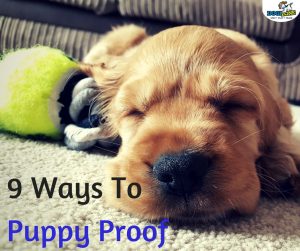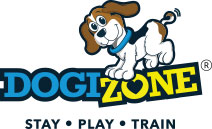9 Ways To Puppy Proof A Home And Yard

Bringing a puppy home is a very exciting time for everyone. To make this a very smooth transition and to prevent any unnecessary stress for yourself or the new addition to the family, here are 12 essential puppy proofing tasks to complete before the new dog comes home.
1. Set up a puppy area – using an indoor dog pen or perhaps a specific room, designate a spot for the puppy. This should be an area where the puppy can stay when you are not able to supervise. This space should be free from anything but the bedding, a crate (if you are using one) appropriately sized puppy toys and a non-spill and non-skid water dish with fresh, clean water.
2. Remove interesting things – puppies will find almost anything interesting to chew on. If the dog is going to be in a room take out anything that can seem attractive to chew. This means remote controls, cell phones, shoes, magazines, throw rugs, pillows or anything on low tables that the puppy can reach if they jump up.
3. Tie up curtain poles – curtain poles can easily become wrapped around a puppy’s mouth, head or neck with tragic results. Use holders or tie up the cords to a height that the puppy cannot possibly reach.
4. Use baby gates – using baby gates to block off stairs or to block access to specific rooms of the house is a low-cost investment in providing a safe space for your puppy. Stairs can be particularly difficult for puppies, resulting in falls and injuries.
5. Remove kid‘s toys – children’s toys and toys for dogs are designed very differently. Puppies can demolish a child’s stuffed toys in a very short period. Not only does this make a mess but the eyes, noses and other parts can easily be chewed off and swallowed, posing serious choking risks.
6. Remove electrical cords –any electrical cords at puppy-level will be a problem. They are very appealing to a puppy who may chew on the cord, risking the chance of electrocution.
7. Tablecloths and tassels – anything that hangs down off something such as a tablecloth or a runner with tassels or even without should be removed with the larger breeds. These will naturally move with breezes in the room, enticing the dog to grab the fabric and pull. This will result in any items falling down on the dog.
8. Fence check – go outside and check the fence for holes at the base or in the soil. Ideally, get down and check closely for loose boards. Check to make sure the gate closes and locks and that the puppy cannot get out from the bottom or sides.
9. Remove materials – removal sticks, kid’s toys or anything else the puppy may chew on while outside. Check your plants both indoors and outside for toxicity and remove them or use wire to keep the puppy well away from any that may be toxic.
Remember not to use any chemicals in the house or in the yard where the puppy has access. Keep the garbage can out of the puppy’s area as well to prevent him or her from getting into the trash and eating something that is dangerous.
